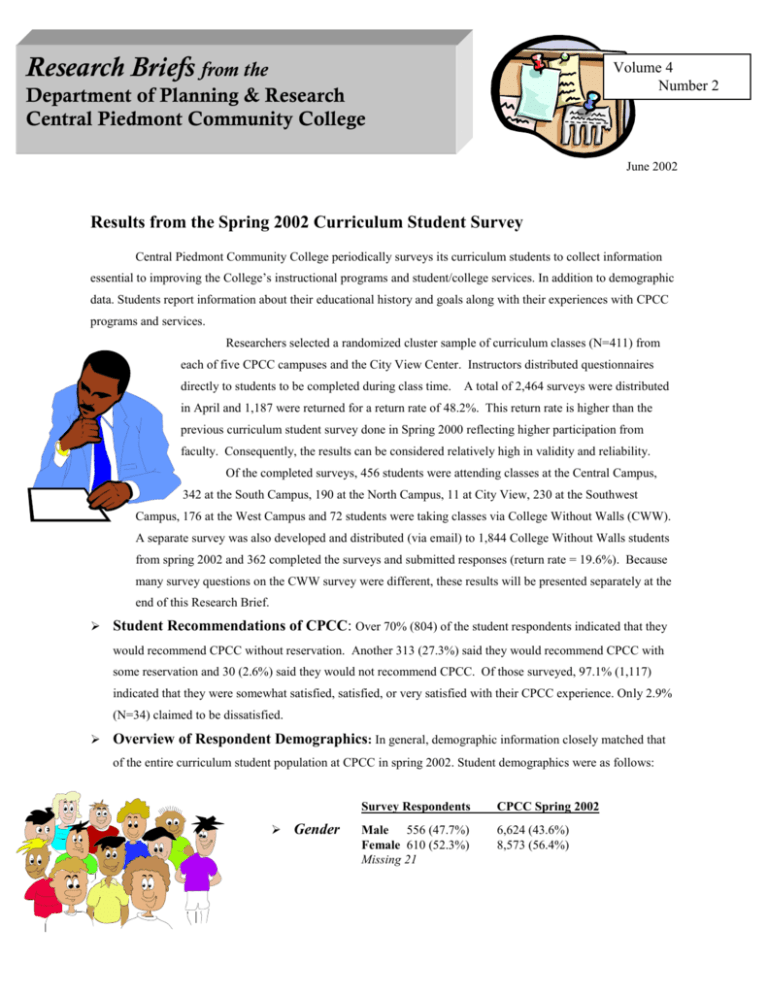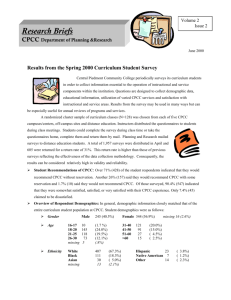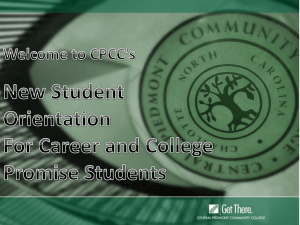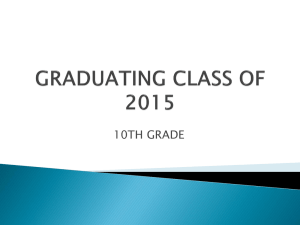1 June 2002 Results from the Spring 2002 Curriculum Student
advertisement

Research Briefs from the Volume 4 Number 2 Department of Planning & Research Central Piedmont Community College June 2002 Results from the Spring 2002 Curriculum Student Survey Central Piedmont Community College periodically surveys its curriculum students to collect information essential to improving the College’s instructional programs and student/college services. In addition to demographic data. Students report information about their educational history and goals along with their experiences with CPCC programs and services. Researchers selected a randomized cluster sample of curriculum classes (N=411) from each of five CPCC campuses and the City View Center. Instructors distributed questionnaires directly to students to be completed during class time. A total of 2,464 surveys were distributed in April and 1,187 were returned for a return rate of 48.2%. This return rate is higher than the previous curriculum student survey done in Spring 2000 reflecting higher participation from faculty. Consequently, the results can be considered relatively high in validity and reliability. Of the completed surveys, 456 students were attending classes at the Central Campus, 342 at the South Campus, 190 at the North Campus, 11 at City View, 230 at the Southwest Campus, 176 at the West Campus and 72 students were taking classes via College Without Walls (CWW). A separate survey was also developed and distributed (via email) to 1,844 College Without Walls students from spring 2002 and 362 completed the surveys and submitted responses (return rate = 19.6%). Because many survey questions on the CWW survey were different, these results will be presented separately at the end of this Research Brief. Student Recommendations of CPCC: Over 70% (804) of the student respondents indicated that they would recommend CPCC without reservation. Another 313 (27.3%) said they would recommend CPCC with some reservation and 30 (2.6%) said they would not recommend CPCC. Of those surveyed, 97.1% (1,117) indicated that they were somewhat satisfied, satisfied, or very satisfied with their CPCC experience. Only 2.9% (N=34) claimed to be dissatisfied. Overview of Respondent Demographics: In general, demographic information closely matched that of the entire curriculum student population at CPCC in spring 2002. Student demographics were as follows: Gender Survey Respondents CPCC Spring 2002 Male 556 (47.7%) Female 610 (52.3%) Missing 21 6,624 (43.6%) 8,573 (56.4%) 2 Age <20 21-25 26-30 31-40 41-50 51+ Missing Ethnicity Survey Respondents CPCC Spring 2002 392 291 157 177 110 48 12 2,921 (19.2%) 4,374 (28.8%) 2,178 (14.3%) 3,022 (19.9%) 1,785 (11.7%) 917 ( 6.0%) Survey Respondents White 762 Black 276 Asian 47 Hispanic 41 Native American 14 Other 33 Missing 14 (33.4%) (24.5%) (13.4%) (15.1%) ( 9.4%) ( 4.1%) Language Spoken in the Home CPCC Spring 2002 (65.0%) (23.5%) ( 4.0%) ( 3.5%) ( 1.2%) ( 2.8%) 9,357 (61.6%) 3,991 (26.3%) 786 ( 5.2%) 602 ( 4.0%) 70 ( .5%) 391 ( 2.6%) English Spanish Other 1,049 (89.7%) 32 ( 2.7%) 88 7.5%) A typical student respondent was female, white, under 30 and employed full or part-time . Economic Indicators for Students Education of Students Prior to Attending CPCC Students were asked to indicate their level of education prior to attending CPCC. Approximately 3% of students surveyed were dually or concurrently enrolled high school students. An additional 32.2% had some college credit when they came to the college and 23.3% had already earned some type of college degree (associate, bachelors, masters, doctorate) prior to attending CPCC. Education Level Less than 12 years High school diploma/GED Some college Associate degree Bachelors degree Masters degree Some graduate school Doctorate or professional degree Missing Number (Percent) 47 (4.0%) 599 (50.7%) 372 (31.5%) 68 ( 5.8%) 72 ( 6.1%) 6 ( .5%) 14 ( 1.2%) 4 ( .3%) 5 Education Level of Students' Parents When asked about the educational level of their parents/guardians, 34.1% of fathers/male guardians and 32.6% of mothers/female guardians were college graduates or had attended graduate school. The survey also indicated that 39.9% of fathers/male guardians had never attended college and 39.4% of mothers/female guardians had never attended college. Number and percent by education levels of both fathers and mothers is as follows: 3 Father/male guardian Less than 12 years High school grad/GED Some college College graduate Graduate school/degree Don’t' know Missing 150 314 246 234 163 58 22 Mother/female guardian (12.9%) (27.0%) (21.1%) (20.1%) (14.0%) ( 5.0%) 121 334 286 275 102 36 33 (10.5%) (28.9%) (24.8%) (23.8%) ( 8.8%) ( 3.1%) Upon further examination, it was determined that 44.6% of male students were first-generation college students and 49.5% of female students were first-generation college students. When these were combined, the survey revealed that: 46.3% of CPCC curriculum students were first-generation college students (neither parent had graduated from college). Current Employment Status Students were asked about their employment status. It was found that 83.5% of curriculum students worked full or part time. Numbers and percents by employment category are as follows: Full time (40 hrs. or more per week) Part-time (21-39 hrs. per week) Part-time (less than 20 hrs. per week) Unemployed Missing 405 343 177 254 8 (34.4%) (29.1%) (15.0%) (21.5%) It should be noted that the percentage of students who are unemployed has increased over the past two years from 16.5% to 21.5%. The percentage of students working full-time decreased from 47.8% to 34.4%. This can be explained by changes in the economy in Mecklenburg County. Students' Personal Annual Salary Students were asked to indicate their personal (not household or family) income. It was found that a greater percentage (54.4%) of CPCC students earn less than $20,000 per year as compared to two years ago (42% in spring 2000). When compared with data collected in spring 2000, a smaller percentage of students (16.4%) reported that they earned more than $40,000. The Spring 2000 survey reported that 22.1% earned more than $40,000. Number and percent by income level are as follows: Income Level Less than $ 10,000 $10 - 19,999 $20 - 29,999 $30 - 39,999 $40 - 49,999 More than $50,000 Missing Number (Percent) 389 (35.0%) 215 (19.4%) 196 (17.7%) 128 (11.5%) 79 ( 7.1%) 103 ( 9.3%) 77 Leading Indic ators 4 Goal in Attending CPCC Students could select multiple reasons for attending the College. Of those surveyed, 63.1% were credential-seeking students (intending to obtain a two year degree, certificate or diploma). Responses indicated that 53.1% of students were transfer students (intending to take classes or complete a degree and transfer to a four- year school). Responses also indicated that 57.9% of students had job-related goals (to improve jobrelated skills for their current / new job, obtain a degree and enter workforce, improve reading, writing and math). An additional 18.5% of students indicated they were taking courses for personal interest. Number and percent by stated goal are as follows: Goal Statement Number (Percent) Obtain 2 yr. degree and enter the workforce Obtain 2 yr. degree and transfer to a 4 yr. school Take courses and transfer to a 4 yr. college Obtain a diploma or certificate Prepare for a different job Personal interest/enrichment Update skills for current job Improve reading, writing and math skills Prepare for my first job 385 (32.4%) 333 (28.1%) 295 (24.9%) 193 (16.3%) 151 (12.7%) 147 (12.4%) 119 (10.0%) 60 ( 5.1%) 50 ( 4.2%) Location and Time of Classes Students indicated all the campuses and times when and where they were currently attending classes. It was found that 38.4% of respondents attended classes at the Central Campus, 28.8% at South, 19.4% at Southwest, 16.0% at North, 14.8% at West and .9% at the City View Center. College Without Walls and off-campus locations accounted for 6.1% and 1.7% respectively. As campuses are developed, more CPCC students are attending classes at more than one campus (College Without Walls was counted as a virtual campus.) Number of campuses attended are as follows: Number (Percent) of Campuses Attended 729 (78.3%) attend classes at only one campus 211 (17.8%) attend classes at two campuses 34 ( 2.9%) attend classes at three campuses 6 ( .5%) attend classes at four campuses Responses also indicated that 72.7% of students attended classes during the day, 51.9% attended at night and 5.9% on the weekend. Of those students, 26.8% were attending both day and night classes and 1.9% were attending classes at all three times, during the day, night and on the weekend. Factors Influencing the Decision to Attend CPCC. Students were asked to rate factors they felt were (1) very unimportant, (2) unimportant, (3) somewhat important, (4) important and (5) very important in their decision to attend CPCC. The factors are ranked below in order of most importance to least importance: 5 % Scoring Factor as Important or Very Important Academic reputation Academic courses/programs offered Low tuition costs Convenient locations Easy transfer of credits Class schedules that allow for work Relevance to job Small class sizes Appearance of grounds/facilities Admission regardless of grades Availability of financial aid Availability of job placement/career counseling Availability of coops, internships, etc. Accessibility by public transportation 87.6% 84.5% 80.9% 79.7% 78.3% 77.7% 64.1% 59.3% 47.6% 45.0% 41.9% 45.6% 40.5% 18.2% Satisfaction with Instructional Elements of the College Students were asked to rate their satisfaction with various elements of CPCC instruction from (1) very dissatisfied to (5) very satisfied. The instructional items in terms of percent satisfied are rank ordered as follows: Quality of instruction Classroom facilities Times classes are offered Campus/site where classes were offered Availability of instructors Quality of faculty advisor Availability of classes Library resources % Satisfied (Somewhat to Very) Item Mean 93.5% 93.6% 89.7% 87.2% 91.3% 88.0% 88.3% 88.1% 3.94 3.91 3.82 3.81 3.74 3.68 3.67 3.65 In general, student respondents were satisfied with the instructional elements at CPCC. Satisfaction with Student Support Services Students were asked to rate their satisfaction with student support services from (1) very unsatisfied to (5) very satisfied. Overall, student respondents were satisfied with service areas at CPCC. Student Services areas are rank ordered from most satisfied to least satisfied as follows based on mean satisfaction: Importance of and Satisfaction with Services % scoring Factor as Important or Very Important % Satisfied (Somewhat to Very) Mean Satisfaction Computer Labs 77.3% 93.2% 4.06 College Webpage Registration Services Security Welcome/Information Center Records/Transcripts Testing/Assessment Center Instructional Labs Student Career Services Library Parking 70.9% 84.9% 79.5% 68.9% 78.5% 82.3% 73.2% 78.6% 77.6% 91.7% 92.6% 92.2% 91.2% 93.5% 92.1% 91.1% 90.5% 90.9% 79.6% 83.3% 3.99 3.98 3.96 3.95 3.90 3.86 3.85 3.81 3.79 3.76 6 Importance of and Satisfaction with Services Student Life Activities Academic Learning/Tutoring Telephone Information Counseling Financial Aid Food Service/Vending Academic Advisement Bookstore Fitness/Weight Room % scoring Factor as Important or Very Important 53.3% 59.6% 68.0% 69.9% 64.4% 58.7% 69.8% 76.6% 48.3% % Satisfied (Somewhat to Very) Mean Satisfaction 86.9% 3.70 89.5% 3.69 3.67 88.2% 85.2% 80.6% 85.3% 84.2% 76.5% 75.1% 3.61 3.59 3.57 3.56 3.41 3.34 Satisfaction with Areas Considered Most Important to Students The Current Curriculum Student Survey asked students to make two assessments of college services. First they were asked to rate the importance of various college services to them as students from (1) unimportant to (4) very important. This assessment was done to help the College determine its performance gaps between what students consider important and their satisfaction with those services. If students do not consider a service to be important, chances are they do not use it and have little or no opinion in regard to satisfaction. The College can focus on student satisfaction with services students deem most important to them. The following services are rank ordered in terms of most important to least important to students. The mean satisfaction score for those students who rated services as important or very important are listed below. Items are rank ordered from greatest importance to students to least importance to students: Service Area % Ranking Item Important or Very Important Mean Satisfaction Score Registration services Parking Bookstore Security Computer Labs Records/Transcripts College Webpage Academic Advising Library Testing/Assessment Centers Instructional Labs Welcome/Information Center Counseling Food Service/Vending Telephone Information Student Career Services Financial Aid/Veterans Benefits Academic Learning/Tutoring Student Life Activities Fitness/Weight Room 74.4% 74.1% 68.7% 60.9% 59.1% 58.7% 58.6% 54.6% 54.4% 49.8% 48.2% 46.9% 45.1% 41.7% 41.4% 33.9% 31.7% 30.2% 27.1% 17.6% 4.12 3.90 3.59 4.16 4.28 4.08 4.27 3.76 4.00 4.14 4.11 4.23 3.76 3.79 3.97 4.10 3.86 3.98 4.06 3.69 7 In general, student satisfaction was higher for students for whom services were important than for those for whom services were not important. Considering only the students for whom services were important, the most highly rated student service areas in terms of satisfaction are rank ordered as follows: Computer Labs The Web Page Welcome/Information Center Security Testing/Assessment Registration Services Instructional Labs Career Services Communication of Information to Students Students were asked to identify important factors associated with the ability to be informed about courses and programs at CPCC. Not surprisingly, the class schedule and the college catalog topped the list. % Indicating Important to Very Important 922 (79.1%) 912 (77.7%) 760 (65.1%) 338 (29.8%) 331 (28.7%) 445 (28.3%) 300 (26.0%) 298 (25.6%) 268 (23.1%) 253 (21.8%) Schedule of Classes College Catalog Internet CPCC Webpage Articles in the Newspaper High School Counselor Circulars Mailed to You High School Teacher Newspaper Ads Television Ads Radio Ads Student Satisfaction by Campus Students were able to indicate the campus where they attended classes. Many students took classes at more than one campus so the numbers at each campus do not add to the total (n=1,187). City View and off-campus were left out of the analysis due to small sample sizes. The demographic profile of student respondents by campus is as follows: Central n=456 Students: South n=342 North n=190 Southwest n=230 West n=176 Gender: Male 38.8% Female 61.2% 51.9% 48.1% 49.2% 50.8% 63.3% 36.7% 46.8% 53.2% Age: < 21 21-30 31-40 41-50 >50 49.7% 28.3% 10.6% 7.9% 3.6% 46.9% 35.3% 5.8% 7.9% 4.2% 19.0% 42.4% 22.6% 13.3% 2.6% 33.1% 35.5% 18.0% 8.7% 4.7% 29.2% 42.0% 16.9% 9.1% 2.7% 8 Students were asked to rate their satisfaction with instructional areas of the college according to a Likerttype scale with (1) indicating very unsatisfied and (5) indicating very satisfied. Means by campus are listed below: Instructional Area Central South North Southwest West Availability of Classes Availability of Instructors Campus/site Where Classes are Offered Classroom Facilities Library Resources Quality of Faculty Advisors Quality of Instruction Times Classes are Offered 3.61 3.71 3.69 3.78 3.72 3.70 3.48 3.58 3.86 3.86 3.77 3.76 3.81 3.99 4.06 3.62 3.70 3.75 3.45 3.54 3.92 3.54 3.80 4.10 3.67 3.62 3.94 3.82 3.70 3.95 3.88 3.49 3.91 3.75 3.64 3.89 3.64 3.91 4.01 4.03 Overall, students were satisfied with elements of instruction across the campuses. Students were also asked to rank their satisfaction with various student and campus services. Mean scores by campus are as follows: Service Area Central South North Southwest West Academic Advising Learning/Tutoring Bookstore Computer Labs CPCC Webpage Counseling Financial Aid Fitness/Weight Room Food Services/Vending Instructional Labs Parking Library Records/Transcripts Registration Services Student Life/Activities Security Student Career Services Telephone Information Testing Center Welcome Center 3.50 3.78 3.55 4.03 4.04 3.63 3.68 3.53 3.59 3.86 3.28 3.96 3.92 3.93 3.61 3.88 3.88 3.72 3.93 3.99 3.67 3.73 3.81 4.20 4.04 3.72 3.58 3.10 3.65 3.85 3.96 3.81 4.03 4.13 3.84 4.00 3.85 3.65 3.78 4.02 3.17 3.38 3.19 3.82 3.81 3.14 3.25 3.34 3.43 3.53 3.69 3.40 3.61 3.82 3.33 3.68 3.53 3.38 3.66 3.67 3.53 3.59 3.12 3.92 3.93 3.65 3.73 3.35 3.47 3.84 3.87 3.82 3.77 3.92 3.65 3.98 3.72 3.63 3.85 3.90 3.85 3.98 3.03 4.27 4.11 3.82 3.62 3.59 3.78 4.10 4.05 3.78 3.96 4.02 3.95 4.29 3.90 3.90 4.00 4.09 Student satisfaction with services varied slightly across campuses with students at West and South ranking most areas slightly higher than students at other campuses. Interest in Student Life In order to expand or improve programs and services, student activities staff wanted to ask students about the types of programs and activities they felt were important. The following percentages are rank-ordered based on what students felt were most important. Program Area Educational Workshops Leadership Development Multi-cultural Programs % Indicating Important to Very Important 54.2% 53.5% 45.0% 9 Program Area % Indicating Important to Very Important Community Services Recreational Activities Student Clubs and Organizations Live Music and Entertainment 44.4% 42.3% 40.6% 37.0% Staff also wanted to know the time of day when students would be most interested in participating in student activities. The following number and percent indicated a preference for the following days and times. Weekday Mornings Weekday Lunchtime Weekday Afternoons Weekday Evenings Weekend Days Weekend Evenings 214 (18.0%) 278 (23.4%) 229 (19.3%) 296 (24.9%) 313 (26.4%) 167 (14.1%) Student activities staff also wanted to know the mediums that are the most effective in communicating with students about programs and services at the various campuses. The following percentages are rank-ordered based on what students felt were the most important means of communication. Communication Method Student Activities Picnic Tomorrow % Indicating Important to Very Important Campus Signs Classroom Announcements Word of Mouth Fliers or Bulletin Boards The SPARK (student newspaper) CPCC – TV 54.5% 53.7% 53.7% 50.3% 29.3% 28.2% Distance Education: Student/College Services, Instructional Elements and Student Satisfaction Due to the nature of distance education students, a separate online survey was created and sent to all College Without Walls Students in online classes during the Spring term, 2002 (N=2,304). Surveys were completed by 362 students resulting in a 16% return rate. Many of the questions on the survey were the same as those of the Current Curriculum Student Survey and were asked to determine the relative importance of various student services to distance education students and their satisfaction with those services. Demographic characteristics of student respondents are compared to those of all CWW students as follows: Gender: Male Female CWW Respondents 77 (22.3%) 269 (77.7%) Race: White African American Asian Hispanic Native American Other 256 (72.7%) 65 (18.5%) 12 ( 3.4%) 6 ( 1.7%) 3 ( .9%) 10 ( 2.8%) Spring 2002 CWW Students 800 (33%) 1,627 (67%) 1,689 (69.6%) 565 (23.3%) 75 ( 3.1%) 46 ( 1.9%) 9 ( .4%) 43 ( 1.8%) 10 Age: < 21 21-30 31-40 41-50 > 50 CWW Respondents Spring 2002 CWW Students 50 (17.0%) 60 (20.4%) 106 (36.1%) 62 (21.1%) 16 ( 5.4%) 331 (13.6%) 1,073 (44.3%) 620 (25.5%) 307 (12.6%) 96 ( 3.9%) Employment Status of Students: Employed Full-time (40 hrs. or more per week) Employed Part-time (>20 hours per week) Employed Part-time (<20 hours per week) Unemployed 191 (53.8%) 61 (17.2%) 32 ( 9.0%) 71 (20.0%) Previous Education Level of Student Prior to Attending CPCC Less than 12 years 2 ( .6%) High School Diploma/GED 121 (33.7%) Some College 148 (41.2%) Associate Degree 33 ( 9.2%) Bachelors Degree 39 (10.9%) Some Graduate School 5 ( 1.4%) Masters Degree 11 ( 3.1%) Doctorate/Professional Degree 0 Goal in Attending CPCC (students could select more than one answer) Obtain 2 yr. degree and transfer to a 4 yr. school 143 (39.7%) Obtain 2 yr. degree and enter the workforce 130 (36.1%) Take courses and transfer to a 4 yr. College 61 (16.9%) Personal interest/enrichment 45.(12.5%) Prepare for a different job 54 (15.0%) Update skills for current job 58 (16.1%) Obtain a diploma or certificate 55 (15.3%) Improve reading, writing and math skills 10 ( 2.8%) Prepare for first job 5 ( 1.4%) Distance education students are slightly different than other students at CPCC. CWW students are older, more are female, fewer are minority, more work fulltime and they were more educated when they came to CPCC. More CWW students are interested in transferring to a four-year college/university. Almost eighty-seven percent (86.7%) of CWW students have taken a traditional course (in the classroom) at CPCC. Distance Education students were asked multiple questions about where and how they use computers for their CPCC classes. Students indicated the location they used primarily for their distance education courses. Student results are rank ordered from greatest to least use as follows (students could list more than one location): Location Number (percent) indicating primary use Home Work CPCC Public Library Friend’s House Other 334 (92.8%) 96 (26.7%) 76 (21.1% 21 ( 5.8%) 14 ( 3.9%) 5 ( 1.4%) Students were asked about the type of Internet connection their computer has and about their Email use with the following results: 11 Type Dial-up Modem DSL/Cable/Roadrunner Don’t know Number (percent) indicating use 181 (50.8%) 162 (45.5%) 13 (3.7%) Email Use Daily Few times a week Once or twice a week Almost never Never 268 (75.1%) 71 (19.9%) 17 ( 4.8%) 1 ( .3% 0 Use of Instant Messaging Yes No 181 (51.1%) 173 (48.9%) Student Type and Class Selection Students were asked about their enrollment status (full or part-time) and the time of day they preferred taking classes. Students were also asked about the preferred method for receiving services. The results were as follows: Student Status Number (percent) Part-time (3-11 credits per term) Full-time (12 or more credits per term) 230 (64.6%) 126 (35.4%) Preferred Time for Taking Classes Number (percent) Daytime Evening Weekend 160 (45.5%) 171 (48.6%) 21 ( 6.0%) Preference for Receiving Services Number (percent) Everything at a distance (services, advising, instruction) Student services on campus (instruction at a distance) Instruction on campus (student services at a distance) Everything in person Other 145 (40.3%) 43 (11.9%) 53 (14.7%) 58 (16.1%) 48 (13.3%) Suggestions made under the “other” category were that students didn’t have to have every service online but they preferred it that way. Many students said they took a common sense approach to taking classes online, such as taking the hard courses in a traditional classroom and the easier ones online or taking their major courses in the traditional classroom and their general education and elective courses online. Comparing Distance Education Classes to Traditional Classroom Courses Students were asked about the number of distance education classes they have taken and if they had taken traditional classroom courses. Results were as follows: 12 Number of Distance Education Classes Taken Number (percent) Have You Taken Traditional Classroom Courses 1 Class 2 Class 3 Class 4 Class 5 or more Classes 122 (34.4%) 70 (19.7%) 45 (12.7%) 42 (11.8%) 76 (21.4%) Yes No 312 (88.4%) 41 (11.6%) Students were asked to compare their level of satisfaction with distance education courses compared to traditional classroom courses according to the following scale: (1) very dissatisfied, (2) dissatisfied, (3) somewhat satisfied, (4) satisfied, (5) very satisfied and (6) no opinion. No opinion answers were treated like missing data and removed from the analysis. Students compared the following elements of instruction: Instructional Area Responsiveness of the instructor to your questions or needs Content preparation demonstrated by the instructor Course materials preparation demonstrated by the instructor Course website/classroom preparation demonstrated by the instructor Degree to which instructor encouraged/supported interaction with other students Productivity of course time Convenience of testing/assessment methods Overall learning experience Distance Course Mean Traditional Course Mean 4.01 4.14 4.25 4.31 4.16 4.32 4.08 4.22 3.90 4.17 4.11 4.17 4.17 4.07 4.03 4.31 Question? Overall, students were satisfied with elements of instruction in both the traditional classroom and via online courses. Students were slightly more satisfied with traditional classroom instruction in the areas of instructor preparation, interaction with other students, responsiveness of instructors and the overall learning experience. Students were slightly more satisfied with distance education classes in the areas of use of class time and convenience. Students were asked to rate their satisfaction with elements of instruction on the same Likert-type scale : (1) very dissatisfied, (2) dissatisfied, (3) somewhat satisfied, (4) satisfied, (5) very satisfied and (6) not used. “Not used” answers were treated like missing data and removed from the analysis. Several additional elements of instruction were assessed for distance education than were for traditional classroom students. The mean scores of CWW students for instructional areas are rank-ordered from most satisfied to least satisfied as follows: Satisfaction with Elements of Instruction: Quality of instruction Format in which classes are offered Library resources Classroom facilities % Satisfied (Somewhat to very) Item Mean 97.1% 87.5% 89.1% 90.8% 3.95 3.84 3.78 3.75 13 Location for materials pick-up Availability of instructors Technical facilities Times classes are offered Quality of faculty advisor Campus/site where classes were offered Availability of classes % Satisfied (Somewhat to very) Item Mean 85.5% 92.8% 83.6% 83.3% 83.6% 80.3% 5.7% 3.65 3.64 3.62 3.58 3.45 3.45 3.43 Overall, CWW students were satisfied with elements of instruction. However, with the exception of "quality of instruction," CWW students ranked elements of instruction slightly lower than did traditional classroom students. It is critical that service for College Without Walls students be evaluated since many of them utilize services on-line or via telephone. Students were asked to rate student/college services according to the same Likerttype scale: : (1) very dissatisfied, (2) dissatisfied, (3) somewhat satisfied, (4) satisfied, (5) very satisfied and (6) not used. “Not used” answers were treated like missing data and removed from the analysis. Students were also asked if they used these services “face-to-face” or on campus. The mean scores of CWW students for students/college service areas are rank-ordered from most satisfied to least satisfied as follows: Satisfaction with Student Services: % Satisfied Registration Services Security/Privacy Issues Records/Transcripts CPCC.EDU On-line Library Computer Labs Instructional Labs Student Career Services Telephone Information Testing/Assessment Center Bookstore Academic Advising Financial Aid Counseling (somewhat to very) Item Mean Used Service Face to Face 94.3% 95.1% 95.7% 93.2% 97.4% 97.2% 96.8% 96.0% 91.7% 90.5% 88.1% 78.8% 92.8% 91.7% 4.32 4.32 4.20 4.16 4.09 4.07 3.92 3.81 3.86 3.84 3.66 3.54 3.38 3.29 20 ( 5.7%) 12 ( 3.5%) 34 ( 9.8%) 2 ( .6%) 11 ( 3.1%) 24 ( 6.8%) 23 ( 6.6%) 24 ( 6.9%) 11 ( 3.1%) 24 ( 6.9%) 75 (21.2%) 51 (14.4%) 26 ( 7.5%) 59 (17.0%) Potential New Services Available On-line: Students were also asked if the following services were available online, would you use them. The following number and percent indicated “yes”: Tutoring Services Student Life/Activities Welcome/Information Center Other Services 213 (60.7%) 161 (46.5%) 242 (69.5%) 42 (20.8%) Suggestions for other services to be made available online were: chat rooms with the instructor, chat rooms with the deans to help improve programs, advisors for online students only, a place to submit questions about 14 college related services (financial aid, advising, records, etc.) and receive prompt answers, bookstore and testing online. Overall, College Without Walls students were satisfied with student/college services and they rated student/college services slightly higher than traditional classroom students. Results Overall, students were satisfied with instructional elements of the College and with student/college services. Since the last curriculum student survey done in spring 2000, several changes in student characteristics have been observed. Some of the major observations made in this study were: Approximately 10% of curriculum students use a language other than English in their homes 46.3% of CPCC curriculum students are first-generation college students 22% of students attend classes at more than one campus The majority of curriculum students are attending to earn a credential (associate degree, certificate or diploma) For the most part, students at the South and West Campuses were more satisfied with elements of instruction and student/college services than students at other campuses. Curriculum students are getting younger o 58.2% were under 25 in 2002 compared to 45.2% in 2000 Curriculum students are less employed o unemployment increased over the past two years from 16.5% 2000 to 21.5% in 2002 o the percentage of students working full-time decreased from 47.8% in 2000 to 34.4% in 2002 Curriculum students earn less money o The percentage of CPCC students earning less than $20,000 per year increased from 42% in spring 2000 to 54.4% in 2002 When compared to traditional students, a greater percentage of College Without Walls students are employed fulltime, have college degrees and are interested in degree programs The Current Continuing Education Student Survey will be available in July or August 2002. A complete copy of the survey results may be obtained from the Planning and Research Web site: Http://inside.cpcc.edu/planning





